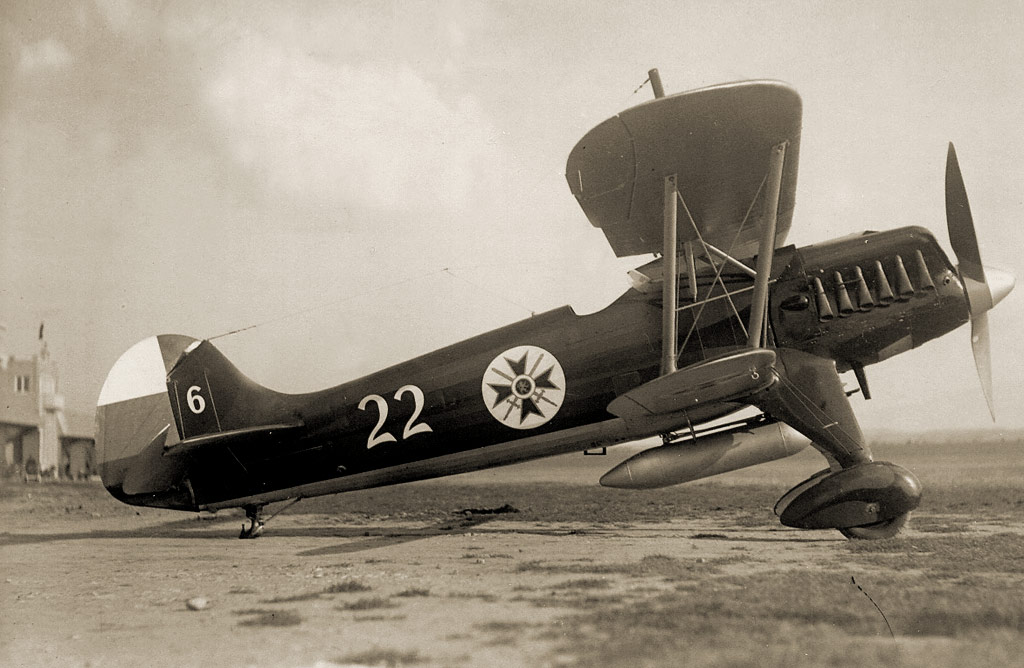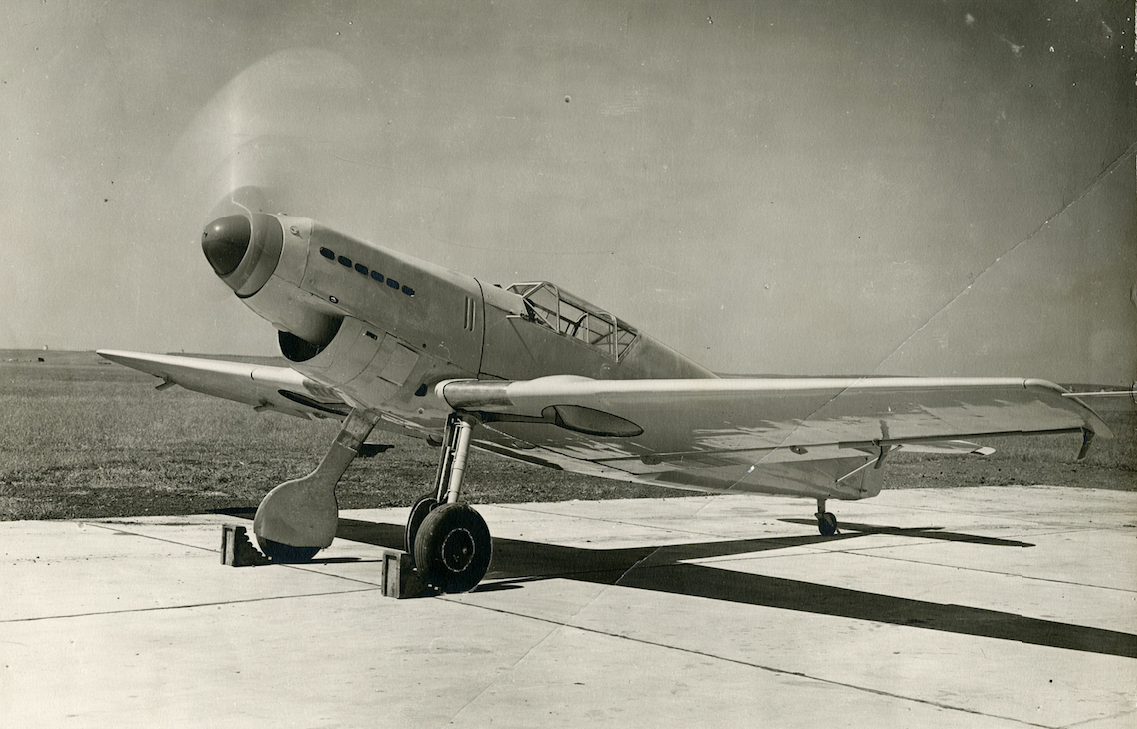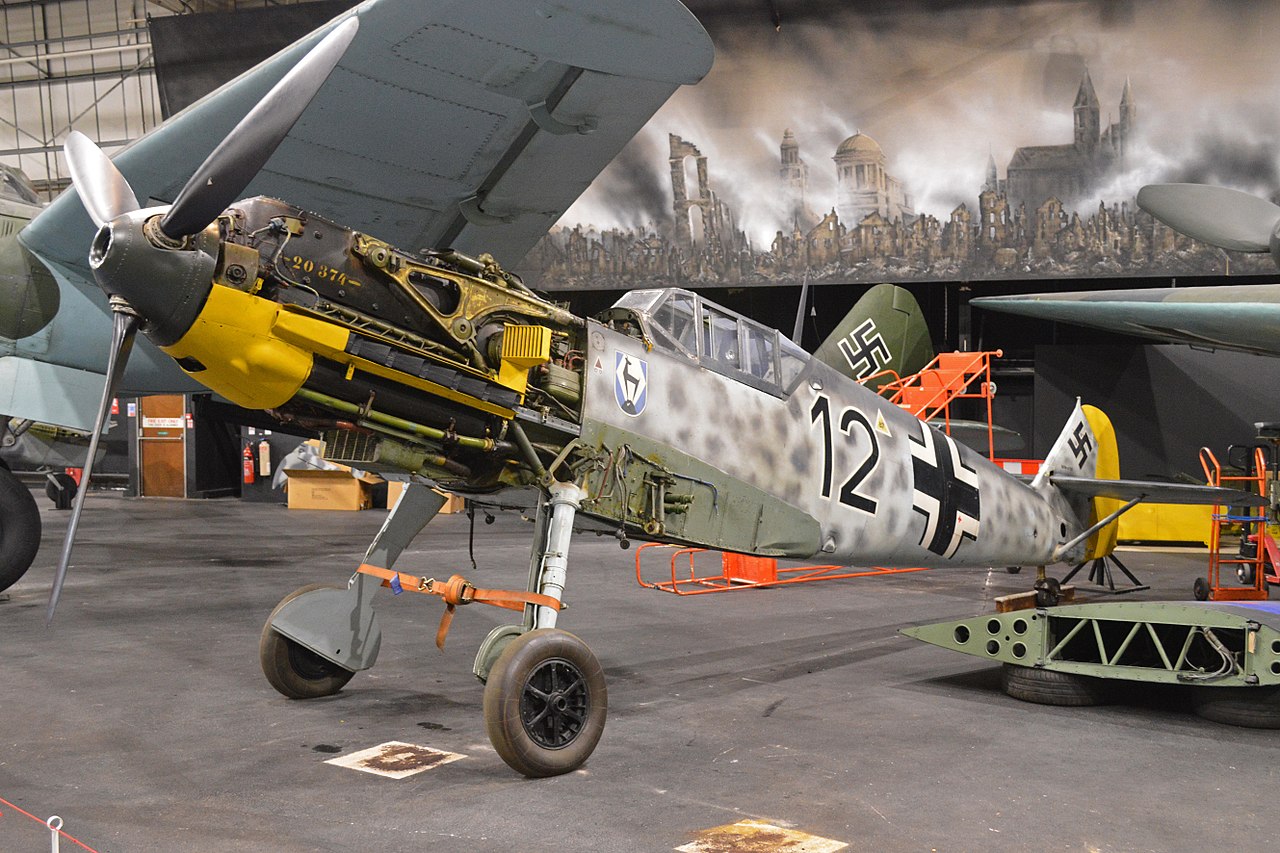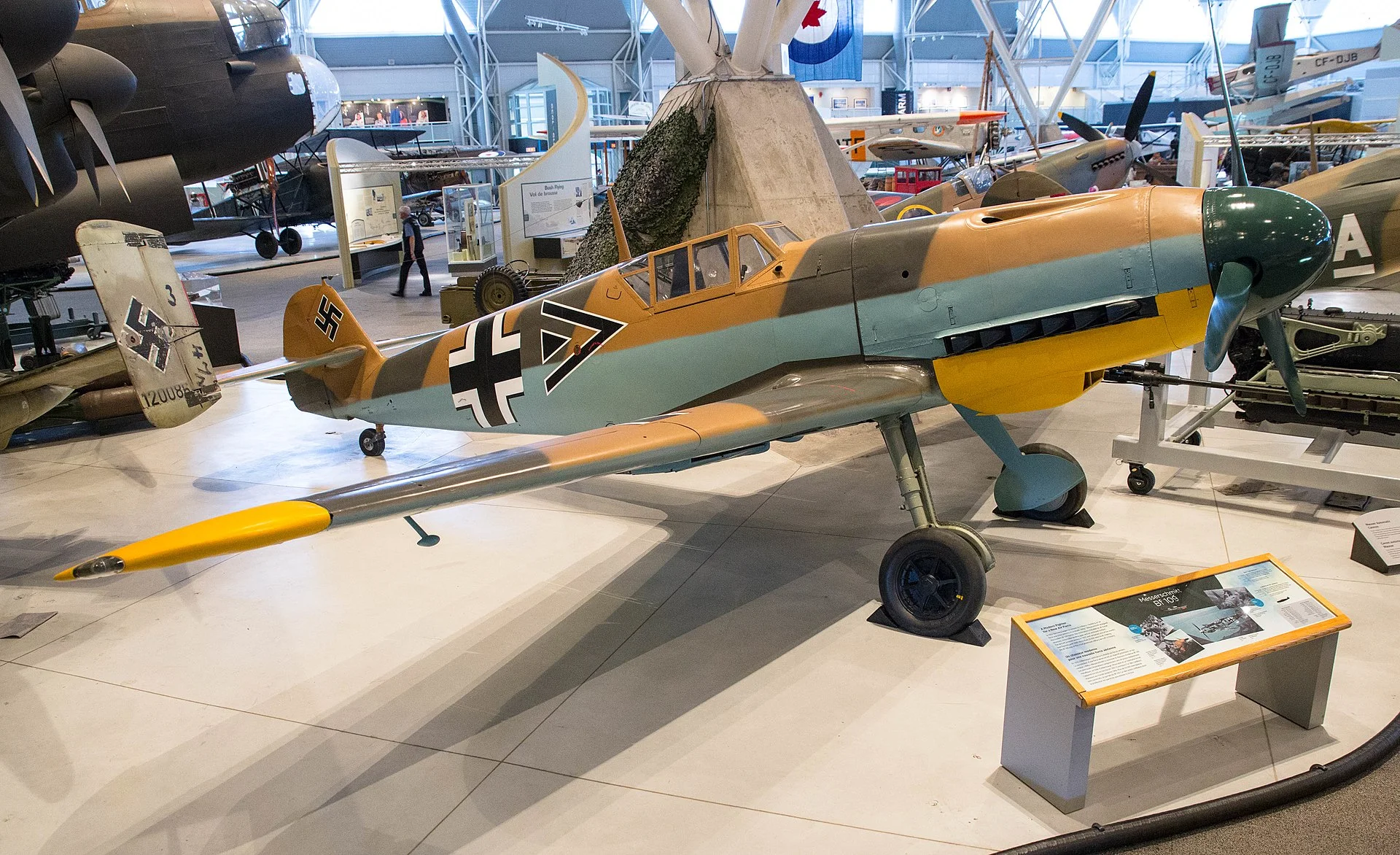
WWII
Messerschmitt Bf 109 – The Best Fighter Ever Built?
The Messerschmitt Bf 109 was one of the key components to Germany’s World War II Luftwaffe. This high-performance monoplane was first introduced into service in 1937 and actually fought in the Spanish civil war.
The type gained notoriety thanks to its futuristic design and was still in service up until 1945 with Germany and all the way until 1965 with Spain.
Anyone with an interest in aviation will have surely heard about this legendary aircraft.
Development
We’ve spoken about the Reich Aviation Ministry many times before in other articles and once again they were responsible for the inception of the Bf 109. In 1933 they outlined four key designs that Germany would need to propel themselves into the future of aviation. We are interested in the third requirement – a single-seat fighter.
Initially, the plan was to have a short-range interceptor aircraft that would replace the outdated Arado Ar 64 and Heinkel He 51 biplane. The specification was going to be tough to accomplish.
 The He 51 was publicly an advanced trainer, but it had been secretly designed as a fighter for the Luftwaffe. It was obsolete as soon as it entered service.
The He 51 was publicly an advanced trainer, but it had been secretly designed as a fighter for the Luftwaffe. It was obsolete as soon as it entered service.
It would be required to achieve a speed of 250 mph (400 km/h) at almost 20,000 ft (6,000 m). On top of this, it must achieve the altitude in less than 17 minutes.
Incredibly, these requirements were set just 30 years after the first-ever flight was recorded by the Wright brothers. To put this into perspective, that is the same amount of time between now (2022) and 1992, which was when the Airbus A330 first took flight. The A330 is still in service on mass and will not be replaced for years to come.
The power plant for this new aircraft was to be the Jumo 210, but it needed to be interchangeable with the Daimler Benz 600 series (which you can read about here).
These requirements were issued to a number of German aircraft manufacturers who then competed against each other to create a machine that could fulfil them.
Believe it or not, Messerschmitt’s first prototype was actually powered by a Rolls Royce Kestrel engine. They were acquired through a trade with the British – a He 70 in exchange for four Kestrels.
 Bf 109 V1 prototype, which was powered by a Rolls-Royce Kestrel engine, indicated by the exhaust ports. Image by National Air and Space Museum.
Bf 109 V1 prototype, which was powered by a Rolls-Royce Kestrel engine, indicated by the exhaust ports. Image by National Air and Space Museum.
By the third version of the prototype, the Jumo 210 had been installed and thoroughly tested by the Luftwaffe in 1935.
The Bf 109 quickly became the front runner of the competition, with the other manufacturer’s aircraft becoming backup choices.
The biggest criticism was the plane’s high angle when on the ground thanks to its tail dragger configuration, meaning that it was difficult to see when taxing. However, techniques were developed to tax in S shapes so that the pilot could gain visibility of what was ahead.
There was an extremely good reason for this seemingly odd landing gear design: the wings could be removed from the aircraft for servicing without the need for additional equipment to hold it up, as it could stay on its undercarriage. German ingenuity at its finest.
Heinkel’s He 112 was the closest competitor, yet it was heavier and 20 mph (32 km/h) slower. This combined with a fantastic demonstration by Messerschmitt’s test pilot impressed the Luftwaffe and ultimately led to the signing of the contract to go into service.
 Heinkel’s He 112 was beaten by the Bf 109. Despite this, it was built in small numbers and saw some use.
Heinkel’s He 112 was beaten by the Bf 109. Despite this, it was built in small numbers and saw some use.
Design Feats
Messerschmitt had some extremely talented designers. Not only could the wings be removed easily for service, but many other engineering feats were built into the Bf 109.
As per the RLM’s design specifications, they wanted low wing loading. In short, this means low stall speed and high amounts of lift produced.
Surely this is a good thing, right? Well, it has advantages and disadvantages.
Lift equals drag. And drag slows down an aircraft in flight. Messerschmitt felt this was unreasonable for a fighter aircraft and that if they’d followed the specification to the letter and used the engines available, then the Bf 109 would have been slower than the bombers it was likely to encounter.
 The Bf 109’s undercarriage was design in a way that allowed the wings to be removed without having to jack up the aircraft. Image by Alan Wilson CC BY-SA 2.0
The Bf 109’s undercarriage was design in a way that allowed the wings to be removed without having to jack up the aircraft. Image by Alan Wilson CC BY-SA 2.0
An ingenious solution was created. The wings were designed to be smaller than specified – this meant higher speed. To compensate for the reduction in lift, high lift devices were installed on the leading edges of the wings that automatically dropped at low speeds, increasing the wing’s area and therefore greatly improving low speed performance.
This was not the only advanced piece of wing design. Traditionally aircraft used two spars (the main load bearing structure within a wing, forming its backbone) in their wings.
The 109 only had one. It made a D-shaped torsion box within the wing, which was not only stronger but lighter.
Variants
The Bf 109 was produced on mass. Almost 34,000 were built in the 10 years from its first flight to the end of World War II.
The first several pre-war variants – A, B, C and D – all used the underpowered Jumo 210 engine. The first big redesign came with the E model “Emil”, which received an engine upgrade.
Fitted with a DB 601 engine that put down almost 1,100 hp, it was a lot faster than the previous models. Structural changes were also made to accommodate this heavier and more powerful engine.
 The Bf 109E came with a new engine, and 7.7 mm and 20 mm guns. Around 3,500 E models were built. Image by Clemens Vasters CC BY 2.0.
The Bf 109E came with a new engine, and 7.7 mm and 20 mm guns. Around 3,500 E models were built. Image by Clemens Vasters CC BY 2.0.
The Bf 109E saw combat in the Spanish civil war with the Condor legion and was very effective with its new armament. Depending on the specific version of the E – either E-1, E-2 or E-3 – it had four 7.7 mm machine guns or two 7.7 mm machine guns and two 20 mm MG/FF cannons.
The second redesign was the F, “Friedrich”. She had new wings, aerodynamics and an even more powerful 1,332 hp engine for the F-3 and F-4 variants. New armament was also key to this model’s success. The F-1 and F-2 had a 15mm Motorkanone mounted behind the engine, with the barrel running between the cylinder banks and through the propeller hub.
The F-3 and F-4 models had 20 mm MG/151 cannons mounted in the nose. The Bf 109F series was a common sight in the skies during 1940, but was mostly used from 1941 onwards as the E was phased out.
 The Bf 109 from the F onwards came with rounded wing tips. Around 2,500 F models were built in total. Image by Clemens Vasters CC BY 2.0.
The Bf 109 from the F onwards came with rounded wing tips. Around 2,500 F models were built in total. Image by Clemens Vasters CC BY 2.0.
Next came the Gustav, the G model. This was by far the most produced version of the Bf-109 with over 20,000 built. First introduced in 1942, it came with higher performance engines. The 7.7 mm machine guns were also swapped out for 13mm ones.
There were models built from G-1 all the way through G-14. To make things more complicated, the even-numbered versions were unpressurised for air superiority, whilst the odd-numbered ones were built as high altitude fighters.
On top of this, the /U suffix was added to aircraft that had factory-installed parts that uprated the armament. These armaments included underwing gun pods, generally, for hunting bombers. Some G models also had the MK 108 30 mm cannon installed in the nose too.
 The incredible power of the MK 108 autocannon is shown here on this Blenheim IV light bomber, which was hit by the weapon during British tests.
The incredible power of the MK 108 autocannon is shown here on this Blenheim IV light bomber, which was hit by the weapon during British tests.
The final version was the Kurfürst, K series. This was the last-ditch attempt to improve the Bf 109 to help turn the tide of war. There were several variants produced, much like the G series that incorporated gun pods, and heavier armament such as the MK 108 30 mm and even more powerful engines taking them to almost 2,000 horsepower.
Versus the late model Spitfires and P-51D the Bf 109 K had an extremely impressive climb rate and excellent top speed.
Is Bf 109 better than P-51?
The P51 and Bf 109 were both iconic fighter planes from World War II, but they had their own strengths and weaknesses. The P51, or Mustang, was an American plane known for its sleek design and long-range capabilities because of its drop tanks. It was also very agile and good in dogfights.
However, the Bf 109, a German plane, was recognized for its high speed and strong weapons. While it didn’t have the range or agility of the P51, it had powerful engines and a lot of firepower. Another difference was the cockpit design; the Bf 109 had an enclosed cockpit, while the P51 had an open one.
Conclusion
To keep it short, it was good. Very good. This aircraft was flown by three top-scoring aces of all time. The Jagdgeschwader 52 claimed 928 victories. Just Erich Hartmann alone claimed 325 victories. 105 Bf 109 pilots were accredited with scoring over 100 victories each and over 2,500 German pilots were aces (gaining at least five victories).
To say that the Bf 109 was an incredible fighter aircraft is a huge understatement.
Specifications
Crew: 1
Length: 8.9 m (29 ft 4 in)
Wingspan: 9.9 m (32 ft 6 in)
Height: 2.6 m (8 ft 5 in)
Empty weight: 2,247 kg (4,954 lb)
Max takeoff weight: 3,400 kg (7,496 lb)
Powerplant: 1 × Daimler-Benz DB 605A-1 V12 inverted liquid-cooled piston engine 1,455 hp
Maximum speed: 400 mph (640 km/h) at 20,669 ft (6,300 m)
Range: 547–711 mi (880–1,144 km)
Service ceiling: 39,000 ft (12,000 m)
Rate of climb: 3,960 ft/min (20.1 m/s)
Armament: 2 × 13 mm (.51 in) synchronized MG 131 machine guns with 300 rpg
1 × 20 mm (.78 in) MG 151/20 cannon as centerline Motorkanone with 200 rpg or
1 x 30 mm (1.18 in) MK 108 cannon as centerline Motorkanone with 65 rpg (G-6/U4 variant)
News
The Hanging Temple: China’s 1,500-Year-Old Cliffside Marvel of Faith and Engineering
The Hanging Temple: China’s 1,500-Year-Old Cliffside Marvel of Faith and Engineering Perched precariously on the cliffs of Mount Heng in Shanxi Province, China, the Hanging Temple, also known as Xuankong Temple, Hengshan Hanging Temple, or Hanging Monastery, is an architectural…
The Willendorf Venus: A 30,000-Year-Old Masterpiece Reveals Astonishing Secrets
The Willendorf Venus: A 30,000-Year-Old Masterpiece Reveals Astonishing Secrets The “Willendorf Venus” stands as one of the most revered archaeological treasures from the Upper Paleolithic era. Discovered in 1908 by scientist Johann Veran near Willendorf, Austria, this small yet profound…
Unveiling the Maya: Hallucinogens and Rituals Beneath the Yucatán Ball Courts
Unveiling the Maya: Hallucinogens and Rituals Beneath the Yucatán Ball Courts New archaeological research has uncovered intriguing insights into the ritual practices of the ancient Maya civilization. The focus of this study is a ceremonial offering found beneath the sediment…
Uncovering the Oldest Agricultural Machine: The Threshing Sledge’s Neolithic Origins
Uncovering the Oldest Agricultural Machine: The Threshing Sledge’s Neolithic Origins The history of agricultural innovation is a fascinating journey that spans thousands of years, and one of the earliest known agricultural machines is the threshing sledge. Recently, a groundbreaking study…
Nara’s Ancient Sword: A 1,600-Year-Old Protector Against Evil Spirits
Nara’s Ancient Sword: A 1,600-Year-Old Protector Against Evil Spirits In a remarkable discovery that has captured the attention of archaeologists and historians alike, a 7.5-foot-long iron sword was unearthed from a 1,600-year-old burial mound in Nara, Japan. This oversized weapon,…
The Inflatable Plane, Dropped Behind the Lines for Downed Pilots
Experimental The Inflatable Plane, Dropped Behind the Lines for Downed Pilots The Inflatoplane from Goodyear was an unconventional aircraft developed by the Goodyear Aircraft Company, a branch of the renowned Goodyear Tire and Rubber Company, also famed for the Goodyear…
End of content
No more pages to load











